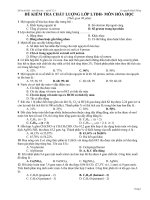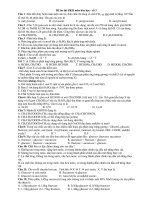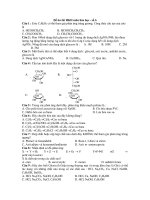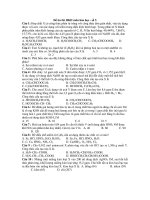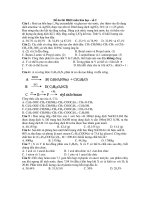Đề ôn thi thử môn hóa (743)
Bạn đang xem bản rút gọn của tài liệu. Xem và tải ngay bản đầy đủ của tài liệu tại đây (103.48 KB, 5 trang )
869.e1
• eBOX 71.2 Nonosmotic Stimuli Associated With Syndrome of Inappropriate Antidiuretic Hormone
CNS Disorders
Drugs
Infection
Meningitis
Encephalitis, including human immunodeficiency virus/acquired immunodeficiency syndrome encephalitis
Brain abscess
Rocky Mountain spotted fever
Mass lesions
Subarachnoid or subdural hemorrhage
Cerebral thrombosis or hemorrhage
Brain tumors
Head trauma with cerebral edema
Hydrocephalus
Cavernous sinus thrombosis
Guillain-Barré syndrome
Multiple sclerosis
Hypoxic encephalopathy, including neonatal hypoxic-ischemic encephalopathy
Pituitary disease
Acute psychosis
Other
Antidiuretic hormone analogs (vasopressin, desmopressin/1-deamino-8-Darginine vasopressin, oxytocin)
Vincristine
Salicylates
Chlorpropamide
Cyclophosphamide
Carbamazepine
Barbiturates
Colchicine
Haloperidol
Fluphenazine
Tricyclic antidepressants and selective serotonin reuptake inhibitors
Clofibrate
Indomethacin and nonsteroidal antiinflammatory drugs
Interferon
Ecstasy (3,4-methylenedioxy-methamphetamine)
Pulmonary Disease
Infection
Bacterial and viral pneumonias
Pulmonary abscess
Tuberculosis
Aspergillosis
Asthma
Respiratory failure with positive pressure ventilation
Tumors
Carcinomas of the lung, oropharynx, gastrointestinal tract (including the
pancreas), and genitourinary tract
Lymphoma, thymoma
Ewing sarcoma, mesothelioma
Miscellaneous
High levels of inflammatory mediators
Nausea/vomiting
Pain or emotional stress
General anesthesia
Marathon running or endurance exercise
Hereditary (gain-of-function mutations in the vasopressin V2 receptor)
870
S E C T I O N V I I Pediatric Critical Care: Renal
Treatment
Prevention
Stimuli for ADH release are frequently present in both surgical
and nonsurgical ICU patients, putting them at risk for hyponatremia. Use of hypotonic intravenous (IV) maintenance fluids
increases the risk for development of hyponatremia. The appropriate administration of isotonic IV fluids in these patients will
decrease the incidence of hyponatremia.9,10,87–92 For patients with
severe SIADH or CSW, however, the use of isotonic fluids alone
may not be adequate to prevent life-threatening disturbances in
sodium and water balance. Thoughtful monitoring of sodium
levels is mandatory, along with avoidance of large volumes of
hypotonic fluids.
Therapy
The time course over which hyponatremia develops is a key determinant of the therapeutic approach. Severe hyponatremia is associated with significant morbidity and mortality and requires
urgent attention. Even with milder hyponatremia, critically ill
patients who have serum sodium corrected have improved rates of
mortality and longer survival.93,94 As described previously, acute
hyponatremia produces significant cerebral edema when initial
compensation mechanisms are overwhelmed and more chronic
adaptive mechanisms are not yet fully developed. Hyponatremia
that has been present less than 4 hours can safely be corrected
promptly. When the evolution of hyponatremia is gradual, however, brain cells respond adaptively to prevent cerebral edema.
Thus, there are two essential questions in constructing a therapeutic plan: (1) did hyponatremia evolve rapidly or slowly, and
(2) does the patient have CNS symptoms or imaging suggestive
of cerebral edema? CNS cellular swelling and its symptoms
are more likely with acute hyponatremia or with severe chronic
hyponatremia.95,96 Symptomatic hyponatremia that develops
suddenly—that is, in fewer than 4 hours—can be rapidly reversed
without incurring risk. If asymptomatic hyponatremia has developed over many hours, days, or weeks (i.e., chronic hyponatremia), a gradual, conservative approach is likely to be uncomplicated. Symptomatic chronic hyponatremia, on the other hand,
requires a small but rapid increase in serum sodium to stabilize or
begin to reverse cerebral swelling and to avoid impending herniation, followed by a more gradual correction to normalize sodium
balance. An increase of 5 mEq/L is usually sufficient to halt the
progress of symptomatic cerebral edema and can be achieved with
an initial bolus of 5 to 6 mL/kg of 3% saline. The subsequent
correction rate for patients with either acute symptomatic hyponatremia or any chronic hyponatremia should not exceed
0.5 mEq/L per hour. In acute hyponatremia without CNS symptoms, rates of 0.7 to 1 mEq/L per hour have been reported without increased patient morbidity or mortality. A regimen of hypertonic 3% saline infused at 1 to 2 mL/kg per hour with intermittent
administration of a loop diuretic results in an appropriate correction for those patients for whom “rapid” correction is safe. Further correction may require isotonic fluids or a mixture of isotonic
and hypertonic fluids, particularly in patients with CSW with
high renal sodium excretion. In resistant, severe CSW, mineralocorticoid (fludrocortisone) treatment has been helpful in several
reports.72,97,98 Other protocol approaches are available.99
Prolonged hyponatremia in animal studies is notable for a
striking decrease in total brain amino acid content as well as lower
brain water content.100 When this brain cell adaptation has
occurred, a rapid rise in serum sodium concentration may induce
a shift of water from the ICF to the ECF compartment, resulting
in brain dehydration, brain injury, and the osmotic demyelination
syndrome (ODS).101 Both central pontine and extrapontine myelinolysis have been reported in children.102–105 Extrapontine sites
include the cerebellum, thalamus, basal nuclei, hippocampus,
midbrain, and subcortical white matter.97 Traditional risk factors
for ODS include chronic alcoholism, chronic liver disease, hypoxic/
anoxic episodes, correction beyond serum sodium of 140 mEq/L,
and rapid correction of hyponatremia (more than 25 mEq/L in
48 hours).106,107 Osmotic demyelination can occur, however,
without hyponatremia as a starting point.104,105,108 Large bolus
doses of hypertonic saline may place the patient at risk regardless
of starting sodium concentration. Electrolyte fluctuations around
the time of liver transplantation may account for the risk of myelinolysis noted in these patients.109 Rarely, ODS has been reported in patients with diabetic ketoacidosis but without hyponatremia on admission, including one case in an 18-month-old
child.103,105 Even rapid correction of hypernatremia is a possible
cause of myelinolysis and suggests that pressure effects may be
capable of causing damage to myelinated structures. Symptoms of
osmotic demyelination may include obtundation, quadriplegia,
pseudobulbar palsy, tremor, amnesia, seizures, and coma.110,111
Classically, the clinical presentation is that of a brief period of
recovery from encephalopathy followed by emergence of a lockedin state or various movement disorders.106 When CNS symptoms
concerning for ODS emerge during therapy, long-term neurologic sequelae may be avoided by decreasing serum sodium to its
nadir followed by a slower rate of correction.112–114
In cases of SIADH in which fluid restriction is a feasible option, a decrease in fluid intake, occasionally with the use of oral
sodium supplements, may be all that is required to normalize
serum sodium gradually and safely. In a patient with hypovolemia,
volume status clearly must be corrected in addition to the hyponatremia. Patients with SIADH or fluid-retaining states may
respond to treatment with an ADH receptor antagonist. This receptor blocker group increases urine volume and reduces urine
osmolality, creating a water diuresis that leads to an increase in
serum sodium concentration.115,116 However, evidence for improvement in other clinical outcomes, such as mortality or ICU
LOS, is currently lacking. Conivaptan is an IV ADH V1 and V2
receptor antagonist that is approved for the treatment of euvolemic and hypervolemic hyponatremia in adults.117 Tolvaptan,
an oral ADH V2 receptor antagonist, was approved in 2009 as
therapy for euvolemic or hypervolemic hyponatremia in adult
patients with heart failure, cirrhosis, or SIADH.116 Pediatric use
of the ADH receptor blockers has been reported in the settings of
SIADH and cardiac disease,116–120 but further study of kinetics,
safety, and efficacy will be needed to clarify the clinical role in
pediatrics.
Hypernatremia
As with hyponatremia, hypernatremia can develop with low, normal, or high levels of total body sodium (eBox 71.3). History and
weights are particularly important in evaluating the hydration
state of patients with hypernatremia because a shift in the ICF to
the ECF tends to obscure the physical findings of dehydration.
Accurate assessment of total body sodium and water aids considerably in planning management, although the most important
management principle is the frequent monitoring of the patient’s
progress with treatment adjustments as needed.
870.e1
• eBOX 71.3 Causes of Hypernatremia
Decreased Total Body Sodium
Extrarenal
Vomiting/diarrhea, excessive sweating
Administration of 70% sorbitol
Renal
Osmotic diuresis: mannitol, glucose, urea
Inadequate Intake
Insufficient lactation
Normal Total Body Sodium
Extrarenal
Respiratory insensible water losses
Cutaneous insensible water losses
Fever, burns, phototherapy
Radiant warmers, especially with premature infants
Renal
Diabetes insipidus (DI)
Central DI
Nephrogenic DI
Hypodipsia (reset osmostat)
Increased Total Body Sodium
Administration or ingestion of large sodium loads
Improperly diluted formula
CHAPTER 71 Fluid and Electrolyte Issues in Pediatric Critical Illness
Pathophysiology and Etiology
Low Total Body Sodium
Patients with a low total body sodium level and hypernatremia
have a loss of water in relative excess of sodium losses. Because
the ECF space is hyperosmolar, water movement from the ICF
occurs, with resulting cellular dehydration. Therefore, the ECF
space is somewhat preserved until an extreme degree of hypovolemia is present. Losses of sodium and water may be extrarenal
or renal.
In the pediatric patient, extrarenal losses are commonly seen
from vomiting and diarrhea, although hospital-acquired hypernatremia from insufficient free water administration is a major
concern.121,122 Renal causes include osmotic diuresis from mannitol, hyperglycemia, or increased urea excretion. Infants are
particularly susceptible to hypernatremic dehydration due to their
high surface area/weight ratio and their relative renal immaturity,
which necessitates greater water losses for excretion of a solute
load compared with older children and adults.123 Insufficient
maternal lactation places young infants at risk of hypernatremic
dehydration.
Normal Total Body Sodium
Loss of water occurs without excessive sodium losses in some conditions. Extrarenal losses include (1) increased respiratory losses as
may occur with tachypnea, hyperventilation, or mechanical ventilation with inadequate humidification and (2) transcutaneous
losses associated with fever, burns, extreme prematurity, or use of
phototherapy or radiant warmers in the neonate without adequate
water replacement. Renal losses result from congenital or acquired
diabetes insipidus (DI), either central or nephrogenic. Acquired
forms of DI are more commonly seen in the ICU. Major insults
resulting in central DI include head trauma, tumors, infections,
hypoxic brain injury, neurosurgical procedures, and nontraumatic
brain death. Classically, in experimental animals and in humans,
three stages occur: (1) an initial polyuric phase (hours to several
days), (2) a period of antidiuresis probably due to ADH release
from injured axons (hours to days), and (3) a second period of
polyuria that may or may not resolve.124,125 Sudden onset of polyuria is characteristic, and the conscious patient will often experience a concomitant polydipsia. In the critically ill patient, the inability to access increased water intake—whether from altered
mental status, impaired thirst regulation, or other causes—may
result in life-threatening hypernatremia.126 Patients with the rare
congenital forms of nephrogenic DI, resulting from X-linked alteration of the ADH V2 receptor or from autosomal recessive
changes in the aquaporin II water channel itself, may have repeated
bouts of hypernatremic dehydration.127 Causes of DI are shown in
eBox 71.4.
Increased Total Body Sodium
Hypernatremia with an increased total body sodium level is most
often an iatrogenic problem. In the ICU, hypertonic solutions of
sodium bicarbonate are administered during resuscitation efforts
or as therapy for intractable metabolic acidosis. Additionally, excessive hypertonic saline administration, ingestion by infants of
improperly diluted formula, and dialysis against a high sodium
concentration can contribute to increased total body sodium.
Normonatremic patients with massive edema who undergo a
forced diuresis frequently become mildly hypernatremic because
the induced urine may be hypotonic, with water loss exceeding
sodium loss.
871
Hypernatremia is intentionally induced in patients with TBI as
a form of osmotherapy for control of intracranial hypertension
associated with cerebral edema.128,129 Such patients have tolerated
serum sodium as high as 175 mEq/L when carefully managed.
When the ECF osmolality of these patients is manipulated, the
risks involved with rapid changes in either direction must be kept
in mind.
Signs and Symptoms
Clinical manifestations of hypernatremia, as is the case with hyponatremia, relate predominantly to the CNS. Marked irritability, a high-pitched cry, altered sensorium varying from lethargy to
coma, increased muscle tone, and overt seizure activity may occur
in children with the development of severe hypernatremia over
48 hours or more. Hyperglycemia and hypocalcemia also may occur.
In infants with acute hypernatremia, vomiting, fever, respiratory
distress, spasticity, tonic-clonic seizures, and coma are common.
Death from respiratory failure occurred in experimental animals
when serum osmolality approached 430 mOsm/kg.130 Mortality
in children with severe hypernatremia has ranged from 10% to
45% with chronic and acute hypernatremia, respectively.
Anatomic changes seen with the hyperosmolar state include
loss of volume of brain cells with resultant tearing of cerebral vessels, capillary and venous congestion, subcortical or subarachnoid
bleeding, and venous sinus thrombosis. During the first 4 hours
of experimental acute hypernatremia, brain water significantly
decreases, while the concentration of solutes (electrolytes and
glucose) increases.131 This leads to a partial restitution of brain
volume within a few hours’ time. Over several days, brain volume
normalizes as a result of intracellular accumulation of organic
osmolytes consisting of polyols, amino acids, and methylamines.125,132
Treatment
Whenever possible, therapy of hypernatremia should address correction of the underlying disease process as a primary goal. Correction of dehydration with slow hypernatremia correction is the
target. When sodium exceeds 165 mEq/L, isotonic fluid or colloid may be used for correction of shock or circulatory collapse
and initial reversal of hypernatremia. When hypernatremia has
been present for more than a few hours, the presence of intracellular organic osmolytes dictates a slow rate of correction. Numerous fatal cases of cerebral edema and herniation have occurred
with correction over a 24-hour period, leading to recommendations for correction over no less than 48 hours.133,134 Newer studies suggest that rapid correction of hypernatremia is not associated
with higher risk for mortality, seizure, or cerebral edema in critically ill adults94,135; therefore, the ideal rate of correction remains
unclear. General agreement is that plasma osmolality should not
be decreased more rapidly than 2 mOsm/h, correlating with a rate
of sodium decline that does not exceed 1 mEq/h. In cases of very
severe or long-standing hypernatremia, a more conservative correction rate of 1 mOsm/h (0.5 mEq/h of sodium) may be appropriate. Thus, normalization from extreme hypernatremia may
take several days. Estimated deficits, ongoing maintenance requirements, and additional excessive losses must be accounted for
in calculations of the amount of fluid replacement required.
Central DI is a likely cause of hypernatremia in an ICU patient with high urine volume and low urine osmolality, particularly in patients who have head trauma or who have undergone a
871.e1
• eBOX 71.4 Causes of Diabetes Insipidus
Central
Congenital
Arginine vasopressin, antidiuretic hormone, gene mutations, autosomaldominant or (rarely) autosomal-recessive inheritance
Idiopathic (30%–50% of cases)
Acquired
Head trauma, orbital trauma
Tumors, suprasellar and intrasellar
Encephalitis
Meningitis
Guillain-Barré syndrome
Hypoxic injury, including neonatal hypoxic-ischemic encephalopathy
Postneurosurgical procedures
Cerebral aneurysms, thrombosis, hemorrhage
Histiocytosis
Granulomas
Nontraumatic brain death
Nephrogenic
Congenital
VR2 mutation, X-linked
AQP-2 mutation
Acquired
Chronic kidney disease
Renal tubulointerstitial diseases
Hypercalcemia
K1 depletion
Drugs
Alcohol, lithium, diuretics, amphotericin B, methoxyflurane, demeclocycline
Sickle Cell Disease
Dietary Abnormalities
Primary polydipsia
Decreased sodium chloride intake
Severe protein restriction or depletion

